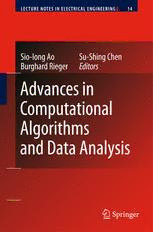Table Of ContentAdvances in Computational Algorithms
and Data Analysis
LectureNotesinElectricalEngineering
Volume14
Forothertitlespublishedinthisseries,goto
http://www.springer.com/7818
Sio-Iong Ao Burghard Rieger Su-Shing Chen
• •
Editors
Advances in Computational
Algorithms and Data
Analysis
(cid:65)(cid:66)(cid:67)
Editors
Sio-IongAo Su-ShingChen
InternationalAssociationofEngineers DepartmentofComputer&Information
Unit1,1/F,37-39HungToRoad Science&Engineering(CISE)
HongKong UniversityofFlorida
HongKong/PRChina POBox116120
GainesvilleFL32611-6120
E450,CSEBuilding
BurghardRieger USA
UniversitätTrier
FBIILinguistische
Datenverarbeitung
Computerlinguistik
Universitätsring15
54286Trier
Germany
ISBN:978-1-4020-8918-3 e-ISBN:978-1-4020-8919-0
LibraryofCongressControlNumber:2008932627
AllRightsReserved
(cid:176)c 2009 SpringerScience+BusinessMediaB.V.
Nopartofthisworkmaybereproduced,storedinaretrievalsystem,ortransmittedinanyformorby
anymeans,electronic,mechanical,photocopying,microfilming,recordingorotherwise,withoutwritten
permissionfromthePublisher,withtheexceptionofanymaterialsuppliedspecificallyforthepurpose
ofbeingenteredandexecutedonacomputersystem,forexclusiveusebythepurchaserofthework.
Printedonacid-freepaper
9 8 7 6 5 4 3 2 1
springer.com
Contents
1 Scaling Exponent for the Healthy and Diseased Heartbeat:
QuantificationoftheHeartbeatIntervalFluctuations .............. 1
ToruYazawaandKatsunoriTanaka
2 CLUSTAG&WCLUSTAG:HierarchicalClusteringAlgorithms
forEfficientTag-SNPSelection ................................ 15
Sio-IongAo
3 TheEffectsofGeneRecruitmentontheEvolvability
andRobustnessofPattern-FormingGeneNetworks .............. 29
AlexanderV.SpirovandDavidM.Holloway
4 ComprehensiveGeneticDatabaseofExpressedSequenceTags
forCoccolithophorids........................................ 51
MohammadRanjiandAhmadR.Hadaegh
5 HybridIntelligentRegressionswithNeuralNetworkandFuzzy
Clustering ................................................. 65
Sio-IongAo
6 DesignofDroDeASys(DrowsyDetectionandAlarmingSystem) .... 75
HrishikeshB.Juvale,AnantS.Mahajan,AshwinA.Bhagwat,
VishalT.Badiger,GaneshD.Bhutkar,PriyadarshanS.Dhabe,
andManikraoL.Dhore
7 The Calculation of Axisymmetric Duct Geometries
for Incompressible Rotational Flow with Blockage Effects
andBodyForces ............................................ 81
VasosPavlika
8 FaultTolerantCacheSchemes................................. 99
H.-yu.TuandSarahTasneem
v
vi Contents
9 ReversibleBinaryCodedDecimalAddersusingToffoliGates ...... 117
RekhaK.James,K.PouloseJacob,andSreelaSasi
10 Sparse Matrix Computational Techniques in Concept
DecompositionMatrixApproximation.......................... 133
ChiShenandDuranWilliams
11 TransferableE-cheques:AnApplicationofForward-SecureSerial
Multi-signatures ............................................ 147
NagarajaiahR.Sunitha,BharatB.R.Amberker,
andPrashantKoulgi
12 AHiddenMarkovModelbasedSpeechRecognitionApproach
toAutomatedCryptanalysisofTwoTimePads................... 159
LiaqatAliKhanandM.S.Baig
13 AReconfigurableandModularOpenArchitectureController:
TheNewFrontiers .......................................... 169
MuhammadFarooq,DaoBoWang,andN.U.Dar
14 AnAdaptiveMachineVisionSystemforParts
AssemblyInspection......................................... 185
JunSun,QiaoSun,andBrianSurgenor
15 Tactile Sensing-based Control System for Dexterous Robot
Manipulation............................................... 199
HanafiahYussof,MasahiroOhka,HirofumiSuzuki,
andNobuyukiMorisawa
16 ANovelKinematicModelforRoughTerrainRobots.............. 215
JosephAuchter,CarlA.Moore,andAshitavaGhosal
17 BehaviorEmergenceinAutonomousRobotControl
byMeansofEvolutionaryNeuralNetworks ..................... 235
RomanNeruda,StanislavSlusˇny´,andPetraVidnerova´
18 SwarmEconomics........................................... 249
SanzaKazadiandJohnLee
19 MachinesImitatingHumans:AppearanceandBehaviour
inRobots................................................... 279
QaziS.M.Zia-ul-Haque,ZhiliangWang,andXueyuanZhang
20 ReinforcedART(ReART)forOnlineNeuralControl ............. 293
DamjeeD.EdiriweeraandIanW.Marshall
21 TheBumpHuntingbytheDecisionTree
withtheGeneticAlgorithm ................................... 305
HideoHirose
Contents vii
22 MachineLearningApproachesfortheInversionoftheRadiative
TransferEquation........................................... 319
EstebanGarcia-Cuesta,FernandodelaTorre,andAntonioJ.deCastro
23 EnhancingthePerformanceofEntropyAlgorithm
usingMinimumTreeinDecisionTreeClassifier.................. 333
KhalafKhatatnehandIbrahiemM.M.ElEmary
24 NumericalAnalysisofLargeDiameterButterflyValve ............ 349
ParkYoungchulandSongXueguan
25 AxialCrushingofThin-WalledColumnswithOctagonalSection:
ModelingandDesign ........................................ 365
YuchengLiuandMichaelL.Day
26 AFastStateEstimationMethodforDCMotors .................. 381
GabrielaMamani,JonathanBecedas,VicenteFeliu,
andHeberttSira-Ram´ırez
27 FlatnessbasedGPIControlforFlexibleRobots .................. 395
JonathanBecedas,VicenteFeliu,andHeberttSira-Ram´ırez
28 EstimationofMass-Spring-DumperSystems .................... 411
JonathanBecedas,GabrielaMamani,VicenteFeliu,
andHeberttSira-Ram´ırez
29 MIMOPIDControllerSynthesiswithClosed-LoopPole
Assignment ................................................ 423
Tsu-ShuanChangandA.NazliGu¨ndes¸
30 RobustDesignofMotorPWMControlusingModeling
andSimulation ............................................. 439
WeiZhan
31 Modeling,ControlandSimulationofaNovelMobile
RoboticSystem ............................................. 451
XiaoliBai,JeremyDavis,JamesDoebbler,JamesD.Turner,
andJohnL.Junkins
32 AllCircuitsEnumerationinMacro-EconometricModels .......... 465
Andre´ A.Keller
33 NoiseandVibrationModelingforAnti-LockBrakeSystems ....... 481
WeiZhan
34 InvestigationofSinglePhaseApproximationandMixtureModel
onFlowBehaviourandHeatTransferofaFerrofluidusingCFD
Simulation ................................................. 495
MohammadMousavi
viii Contents
35 TwoLevelParallelGrammaticalEvolution...................... 509
PavelOsˇmera
36 Genetic Algorithms for Scenario Generation in Stochastic
Programming:MotivationandGeneralFramework ............... 527
JanRoupecandPavelPopela
37 NewApproachofRecurrentNeuralNetworkWeightInitialization.. 537
RobertoMarichal,J.D.Pin˜eiro,E.J.Gonza´lez,andJ.M.Torres
38 GAHC:HybridGeneticAlgorithm............................. 549
RadomilMatousek
39 ForecastingInflationwiththeInfluenceofGlobalization
usingArtificialNeuralNetwork-basedThinandThickModels ..... 563
Tsui-FangHu,IkerGondraLuja,Hung-ChiSu,andChin-ChihChang
40 Pan-TiltMotionEstimationUsingSuperposition-TypeSpherical
Compound-LikeEye......................................... 577
Gwo-LongLinandChi-ChengCheng
Chapter 1
Scaling Exponent for the Healthy and Diseased
Heartbeat
Quantification of the Heartbeat Interval Fluctuations
ToruYazawaandKatsunoriTanaka*
Abstract“Alternans”isanarrhythmiaexhibitingalternatingamplitudeoralternat-
ingintervalfromheartbeattoheartbeat,whichwasfirstdescribedin1872byTraube.
Recently alternans was finally recognized as the harbinger of a cardiac disease
because physicians noticed that an ischemic heart exhibits alternans. To quantify
irregularityof the heartbeat including alternans, weused thedetrended fluctuation
analysis(DFA).Werevealedthatinboth,animalmodelsandhumans,thealternans
rhythmlowersthescalingexponent.Thiscorrespondencedescribesthatthescaling
exponentcalculatedbytheDFAreflectsariskforthe“failing”heart.
Keywords Alternans·Animalmodels·Crustaceans·DFA·Heartbeat
1.1 Introduction
My persimmon tree bears rich fruits every other year. A climatologist report that
globalatmosphericoxygenhasbistability[1].Period-2issuchanintriguingrhythm
innature.Thecardiac“Alternans”isanotherperiod-2.Incardiacperiod-2,theheart-
beat is alternating the amplitude/interval from beat to beat on the electrocardio-
gram (EKG). Alternans has remained an electrocardiographic curiosity for more
thanthreequartersofacentury[2,3].Recently,alternansisrecognizedasamarker
for patients at an increased risk of sudden cardiac death [2–7]. In our physiologi-
cal experiments on the hearts in the 1980s, we have noticed that alternans is fre-
quentlyobservablewiththe“isolated”heartsofcrustaceans(Note:Atthisisolated
T.Yazawa((cid:1))andK.Tanaka
DepartmentofBiologicalScience,TokyoMetropolitanUniversity,Tokyo,Japan.
Bio-PhysicalCardiologyReseachGroup
e-mail:[email protected];[email protected]
∗Thecontactauthormailingaddress:1705-6-301Sugikubo,Ebina,243-0414Japan,telephoneand
faxnumber:+81-462392350.Presentaddress,228-2Dai,Kumagaya,Saitama,360–0804Japan.
S.-I.Aoetal.(eds.),AdvancesinComputationalAlgorithmsandDataAnalysis, 1
LectureNotesinElectricalEngineering14,
(cid:1)c SpringerScience+BusinessMediaB.V.2009
2 T.YazawaandK.Tanaka
conditiontheheartsoonerorlaterdiesintheexperimentaldish).Wesoonrealized
thatalternansisasignoffuturecardiaccessation.Presently,someauthorsbelieve
thatitistheharbingerforsuddendeath[2,6].Sowecamebacktothecrustaceans,
because we knew the crustaceans are outstanding models. However, details of al-
ternanshavenotbeenstudiedincrustaceans.Soweconsideredthatwecouldstudy
this intriguing rhythm by the detrended fluctuation analysis (DFA), since we have
already demonstrated that the DFA can distinguish a normal heart (intact heart)
from an unhealthy heart (isolated heart) in animal models [8]. We finally revealed
that alternans and lowered scaling exponent occurred concurrently. In this report,
wedemonstratethattheDFAisanadvantageoustoolinanalyzing,diagnosingand
managingthedysfunctionoftheheart.
1.2 Procedure
1.2.1 DFAMethods:Background
The DFA is an analytical method in physics, based on the concept of “scaling”
[9,10]. The DFA was applied to understand a “critical phenomenon” [9,11,12].
Systems near critical points exhibit self-similar properties. Systems that exhibit
self-similarpropertiesarebelievedtobeinvariantunderatransformationofscale.
Finally the DFA was expected to apply to any biological system, which has the
propertyofscaling.
Stanley and colleagues have considered that the heartbeat fluctuation is a phe-
nomenon,whichhasthepropertyofscaling.Theyfirstappliedthescaling-concept
to a biological data in the late 1980s to early 1990s [11,12]. They emphasized on
itspotentialutilityinlifescience[11].However,althoughthenonlinearmethodis
increasingly advancing, a biomedical computation on the heart seems not to have
maturedtechnologically.Indeedwestillaskus:Canwedecodethefluctuationsin
cardiacrhythmstobetterdiagnoseahumandisease?
1.2.2 DFAMethods
We made our own programs for measuring the beat-to-beat intervals and for cal-
culating the approximate scaling exponent of the interval time series. These DFA-
computation methods have already been explained elsewhere [13]. We describe it
herebrieflyonthemostbasiclevel.
Firstly, we obtain the heartbeat data digitized at 1KHz. About 3,000beats are
necessary for a reliable calculation of an approximate scaling exponent. Usually a
continuousrecordforabout50minatasingletestingisrequired.WeuseanEKG
orfingerpressurepulses.

